Comprehensive Report: College Data System, Business Rules, Data Models
VerifiedAdded on 2023/06/04
|9
|1631
|78
Report
AI Summary
This report provides a detailed analysis of a college data system, focusing on business rules and data models. It explores the purpose of a database, emphasizing data redundancy minimization, data integrity enforcement, data sharing, and access control. The report outlines key entities and attributes such as Department, Course, Lecturer, and Student, along with the rules impacting database structure, including data type determination and relationship definition. Furthermore, it discusses various database models, including conceptual, physical, and logical models, and their significance in data storage and management. The report also highlights the importance of database backup and recovery mechanisms. The paper references several sources to support the concepts discussed.

College Data System 1
College Data System
Student’s Name
Professor’s Name
Date
Institution
College Data System
Student’s Name
Professor’s Name
Date
Institution
Paraphrase This Document
Need a fresh take? Get an instant paraphrase of this document with our AI Paraphraser
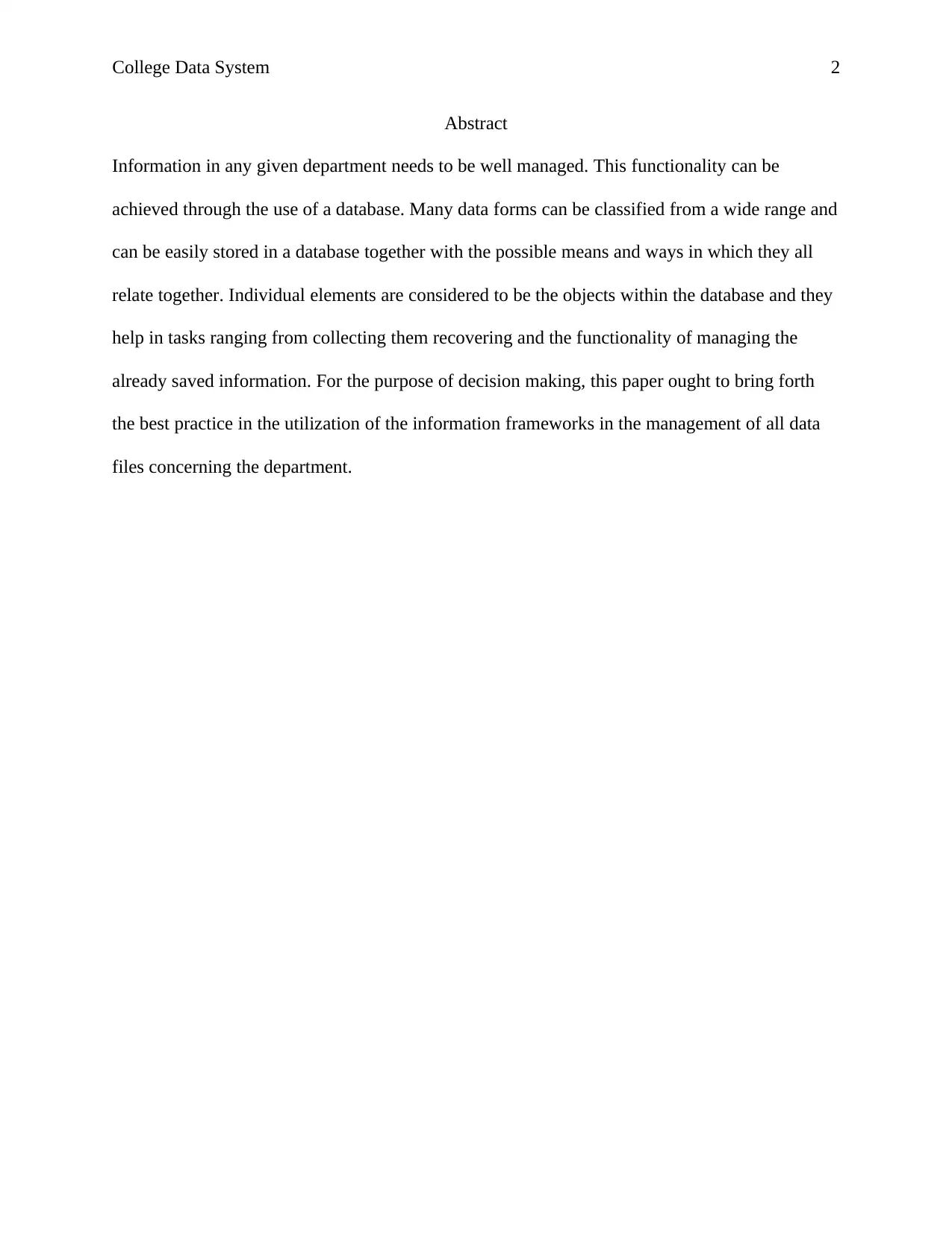
College Data System 2
Abstract
Information in any given department needs to be well managed. This functionality can be
achieved through the use of a database. Many data forms can be classified from a wide range and
can be easily stored in a database together with the possible means and ways in which they all
relate together. Individual elements are considered to be the objects within the database and they
help in tasks ranging from collecting them recovering and the functionality of managing the
already saved information. For the purpose of decision making, this paper ought to bring forth
the best practice in the utilization of the information frameworks in the management of all data
files concerning the department.
Abstract
Information in any given department needs to be well managed. This functionality can be
achieved through the use of a database. Many data forms can be classified from a wide range and
can be easily stored in a database together with the possible means and ways in which they all
relate together. Individual elements are considered to be the objects within the database and they
help in tasks ranging from collecting them recovering and the functionality of managing the
already saved information. For the purpose of decision making, this paper ought to bring forth
the best practice in the utilization of the information frameworks in the management of all data
files concerning the department.
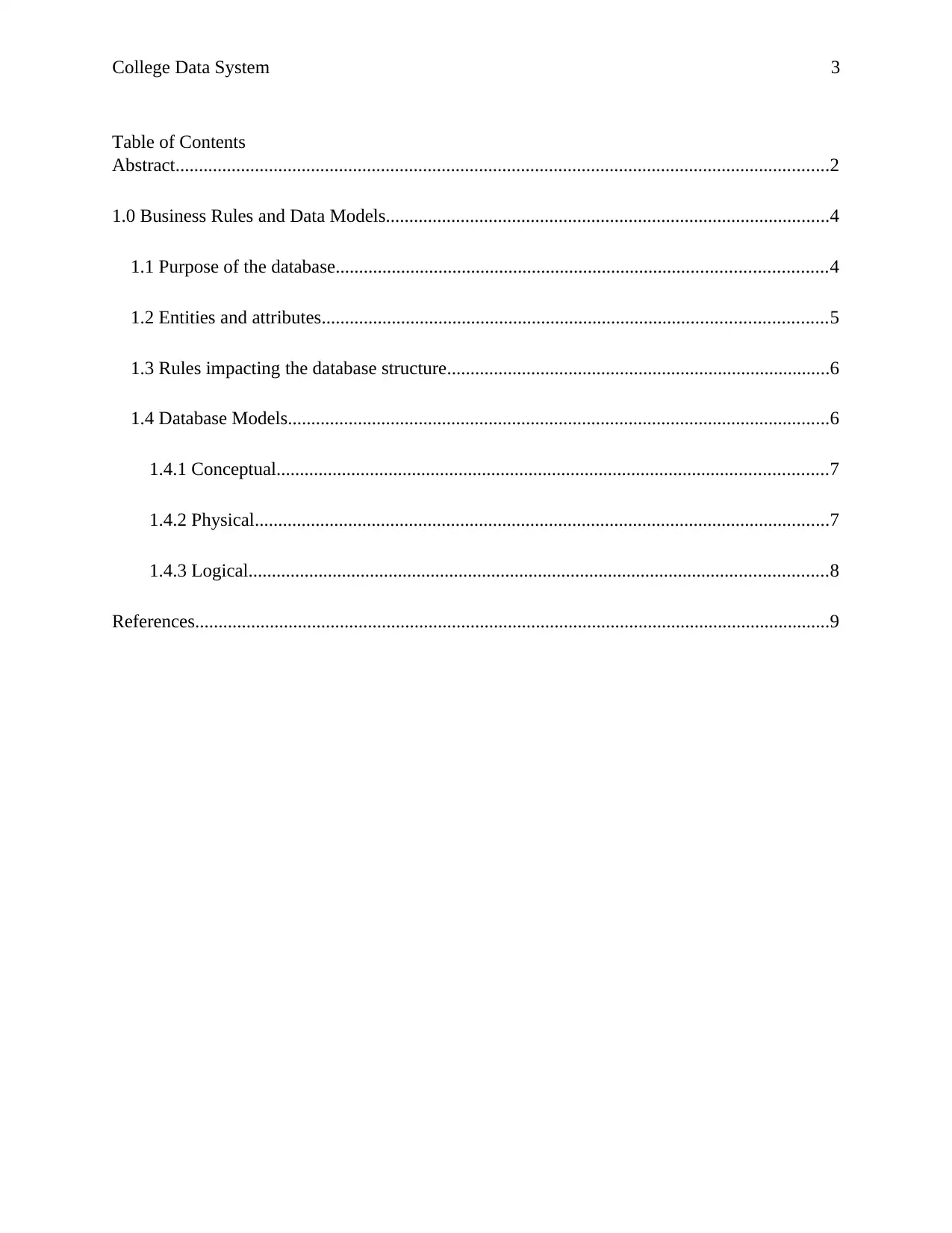
College Data System 3
Table of Contents
Abstract............................................................................................................................................2
1.0 Business Rules and Data Models...............................................................................................4
1.1 Purpose of the database.........................................................................................................4
1.2 Entities and attributes............................................................................................................5
1.3 Rules impacting the database structure..................................................................................6
1.4 Database Models....................................................................................................................6
1.4.1 Conceptual......................................................................................................................7
1.4.2 Physical...........................................................................................................................7
1.4.3 Logical............................................................................................................................8
References........................................................................................................................................9
Table of Contents
Abstract............................................................................................................................................2
1.0 Business Rules and Data Models...............................................................................................4
1.1 Purpose of the database.........................................................................................................4
1.2 Entities and attributes............................................................................................................5
1.3 Rules impacting the database structure..................................................................................6
1.4 Database Models....................................................................................................................6
1.4.1 Conceptual......................................................................................................................7
1.4.2 Physical...........................................................................................................................7
1.4.3 Logical............................................................................................................................8
References........................................................................................................................................9
⊘ This is a preview!⊘
Do you want full access?
Subscribe today to unlock all pages.

Trusted by 1+ million students worldwide
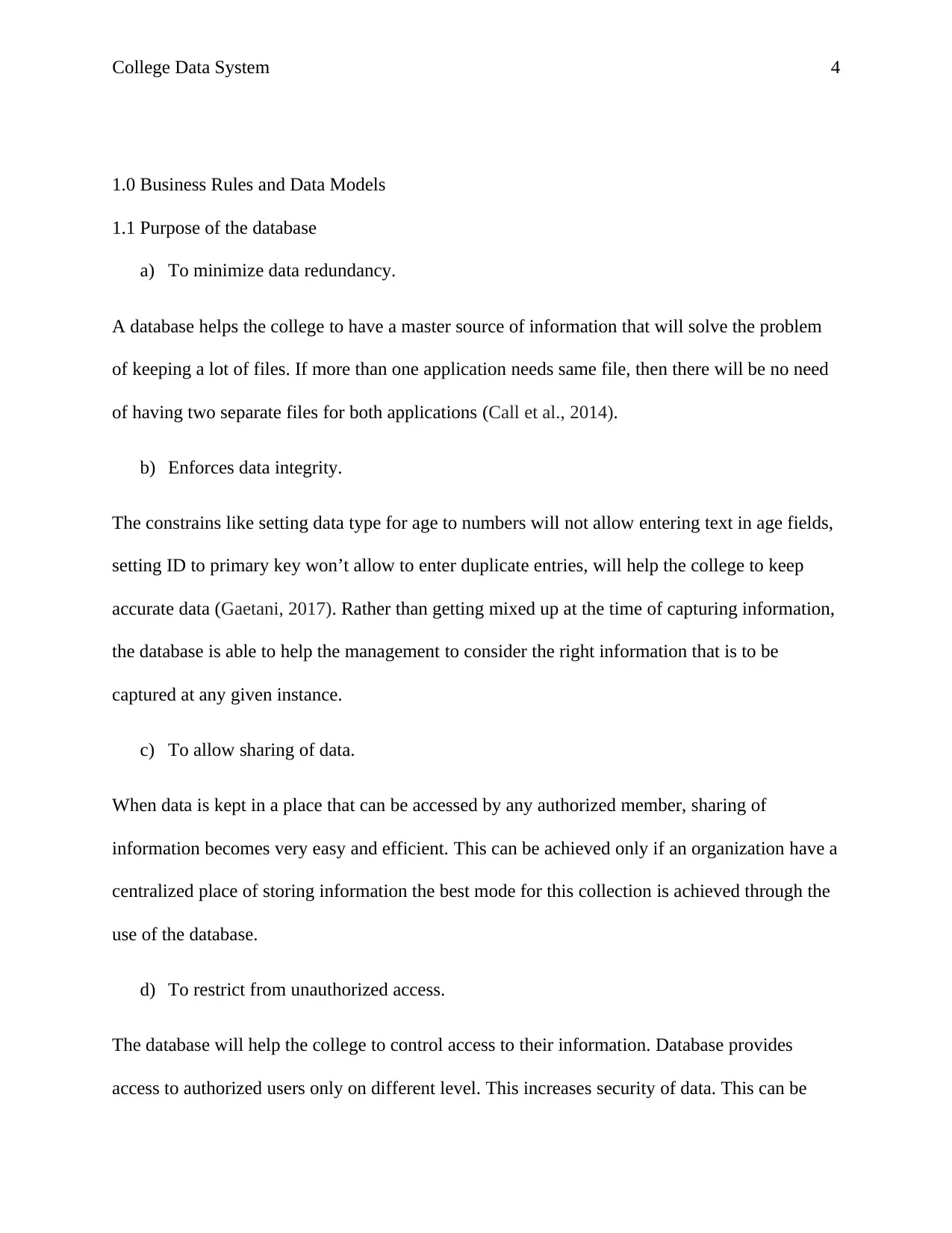
College Data System 4
1.0 Business Rules and Data Models
1.1 Purpose of the database
a) To minimize data redundancy.
A database helps the college to have a master source of information that will solve the problem
of keeping a lot of files. If more than one application needs same file, then there will be no need
of having two separate files for both applications (Call et al., 2014).
b) Enforces data integrity.
The constrains like setting data type for age to numbers will not allow entering text in age fields,
setting ID to primary key won’t allow to enter duplicate entries, will help the college to keep
accurate data (Gaetani, 2017). Rather than getting mixed up at the time of capturing information,
the database is able to help the management to consider the right information that is to be
captured at any given instance.
c) To allow sharing of data.
When data is kept in a place that can be accessed by any authorized member, sharing of
information becomes very easy and efficient. This can be achieved only if an organization have a
centralized place of storing information the best mode for this collection is achieved through the
use of the database.
d) To restrict from unauthorized access.
The database will help the college to control access to their information. Database provides
access to authorized users only on different level. This increases security of data. This can be
1.0 Business Rules and Data Models
1.1 Purpose of the database
a) To minimize data redundancy.
A database helps the college to have a master source of information that will solve the problem
of keeping a lot of files. If more than one application needs same file, then there will be no need
of having two separate files for both applications (Call et al., 2014).
b) Enforces data integrity.
The constrains like setting data type for age to numbers will not allow entering text in age fields,
setting ID to primary key won’t allow to enter duplicate entries, will help the college to keep
accurate data (Gaetani, 2017). Rather than getting mixed up at the time of capturing information,
the database is able to help the management to consider the right information that is to be
captured at any given instance.
c) To allow sharing of data.
When data is kept in a place that can be accessed by any authorized member, sharing of
information becomes very easy and efficient. This can be achieved only if an organization have a
centralized place of storing information the best mode for this collection is achieved through the
use of the database.
d) To restrict from unauthorized access.
The database will help the college to control access to their information. Database provides
access to authorized users only on different level. This increases security of data. This can be
Paraphrase This Document
Need a fresh take? Get an instant paraphrase of this document with our AI Paraphraser
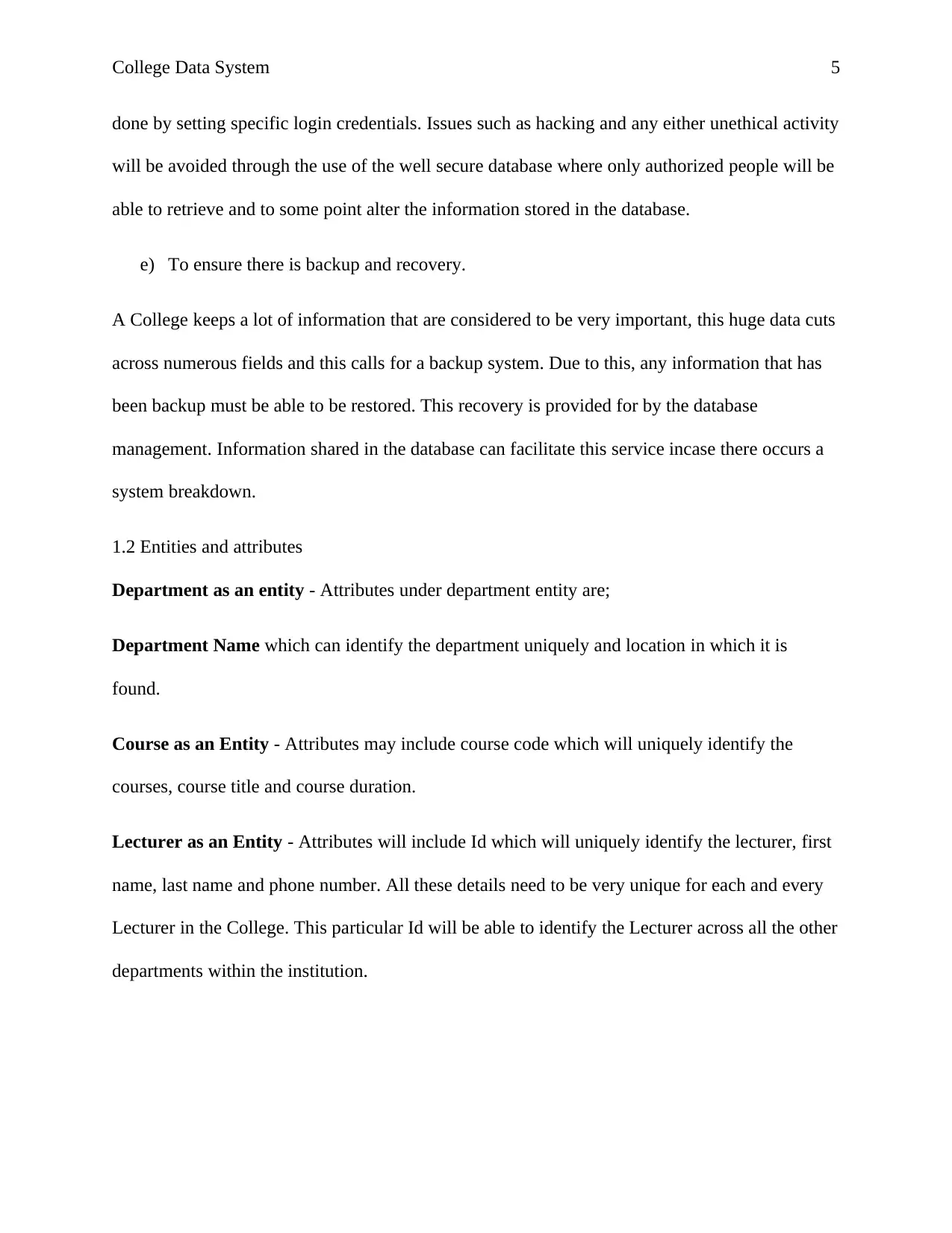
College Data System 5
done by setting specific login credentials. Issues such as hacking and any either unethical activity
will be avoided through the use of the well secure database where only authorized people will be
able to retrieve and to some point alter the information stored in the database.
e) To ensure there is backup and recovery.
A College keeps a lot of information that are considered to be very important, this huge data cuts
across numerous fields and this calls for a backup system. Due to this, any information that has
been backup must be able to be restored. This recovery is provided for by the database
management. Information shared in the database can facilitate this service incase there occurs a
system breakdown.
1.2 Entities and attributes
Department as an entity - Attributes under department entity are;
Department Name which can identify the department uniquely and location in which it is
found.
Course as an Entity - Attributes may include course code which will uniquely identify the
courses, course title and course duration.
Lecturer as an Entity - Attributes will include Id which will uniquely identify the lecturer, first
name, last name and phone number. All these details need to be very unique for each and every
Lecturer in the College. This particular Id will be able to identify the Lecturer across all the other
departments within the institution.
done by setting specific login credentials. Issues such as hacking and any either unethical activity
will be avoided through the use of the well secure database where only authorized people will be
able to retrieve and to some point alter the information stored in the database.
e) To ensure there is backup and recovery.
A College keeps a lot of information that are considered to be very important, this huge data cuts
across numerous fields and this calls for a backup system. Due to this, any information that has
been backup must be able to be restored. This recovery is provided for by the database
management. Information shared in the database can facilitate this service incase there occurs a
system breakdown.
1.2 Entities and attributes
Department as an entity - Attributes under department entity are;
Department Name which can identify the department uniquely and location in which it is
found.
Course as an Entity - Attributes may include course code which will uniquely identify the
courses, course title and course duration.
Lecturer as an Entity - Attributes will include Id which will uniquely identify the lecturer, first
name, last name and phone number. All these details need to be very unique for each and every
Lecturer in the College. This particular Id will be able to identify the Lecturer across all the other
departments within the institution.
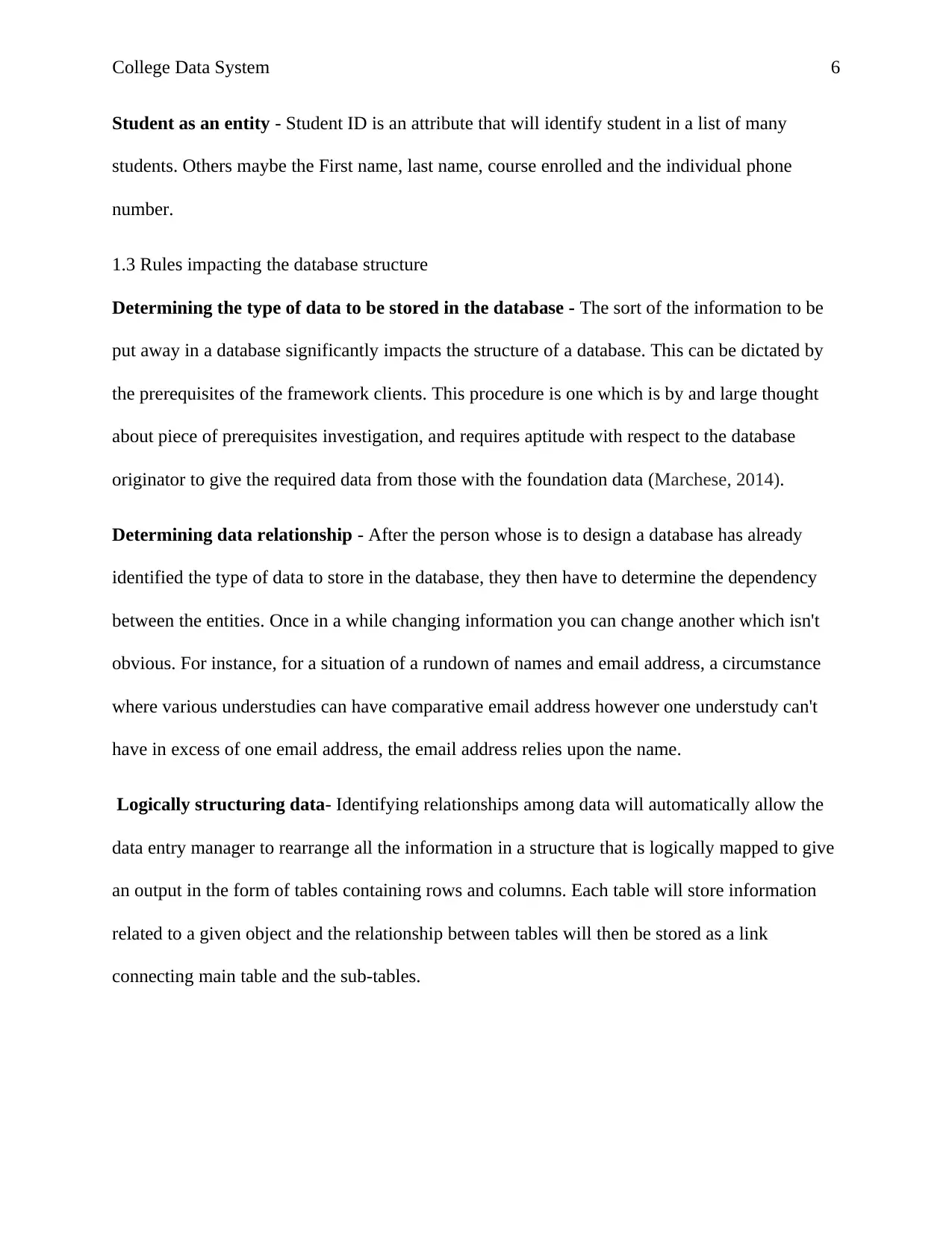
College Data System 6
Student as an entity - Student ID is an attribute that will identify student in a list of many
students. Others maybe the First name, last name, course enrolled and the individual phone
number.
1.3 Rules impacting the database structure
Determining the type of data to be stored in the database - The sort of the information to be
put away in a database significantly impacts the structure of a database. This can be dictated by
the prerequisites of the framework clients. This procedure is one which is by and large thought
about piece of prerequisites investigation, and requires aptitude with respect to the database
originator to give the required data from those with the foundation data (Marchese, 2014).
Determining data relationship - After the person whose is to design a database has already
identified the type of data to store in the database, they then have to determine the dependency
between the entities. Once in a while changing information you can change another which isn't
obvious. For instance, for a situation of a rundown of names and email address, a circumstance
where various understudies can have comparative email address however one understudy can't
have in excess of one email address, the email address relies upon the name.
Logically structuring data- Identifying relationships among data will automatically allow the
data entry manager to rearrange all the information in a structure that is logically mapped to give
an output in the form of tables containing rows and columns. Each table will store information
related to a given object and the relationship between tables will then be stored as a link
connecting main table and the sub-tables.
Student as an entity - Student ID is an attribute that will identify student in a list of many
students. Others maybe the First name, last name, course enrolled and the individual phone
number.
1.3 Rules impacting the database structure
Determining the type of data to be stored in the database - The sort of the information to be
put away in a database significantly impacts the structure of a database. This can be dictated by
the prerequisites of the framework clients. This procedure is one which is by and large thought
about piece of prerequisites investigation, and requires aptitude with respect to the database
originator to give the required data from those with the foundation data (Marchese, 2014).
Determining data relationship - After the person whose is to design a database has already
identified the type of data to store in the database, they then have to determine the dependency
between the entities. Once in a while changing information you can change another which isn't
obvious. For instance, for a situation of a rundown of names and email address, a circumstance
where various understudies can have comparative email address however one understudy can't
have in excess of one email address, the email address relies upon the name.
Logically structuring data- Identifying relationships among data will automatically allow the
data entry manager to rearrange all the information in a structure that is logically mapped to give
an output in the form of tables containing rows and columns. Each table will store information
related to a given object and the relationship between tables will then be stored as a link
connecting main table and the sub-tables.
⊘ This is a preview!⊘
Do you want full access?
Subscribe today to unlock all pages.

Trusted by 1+ million students worldwide
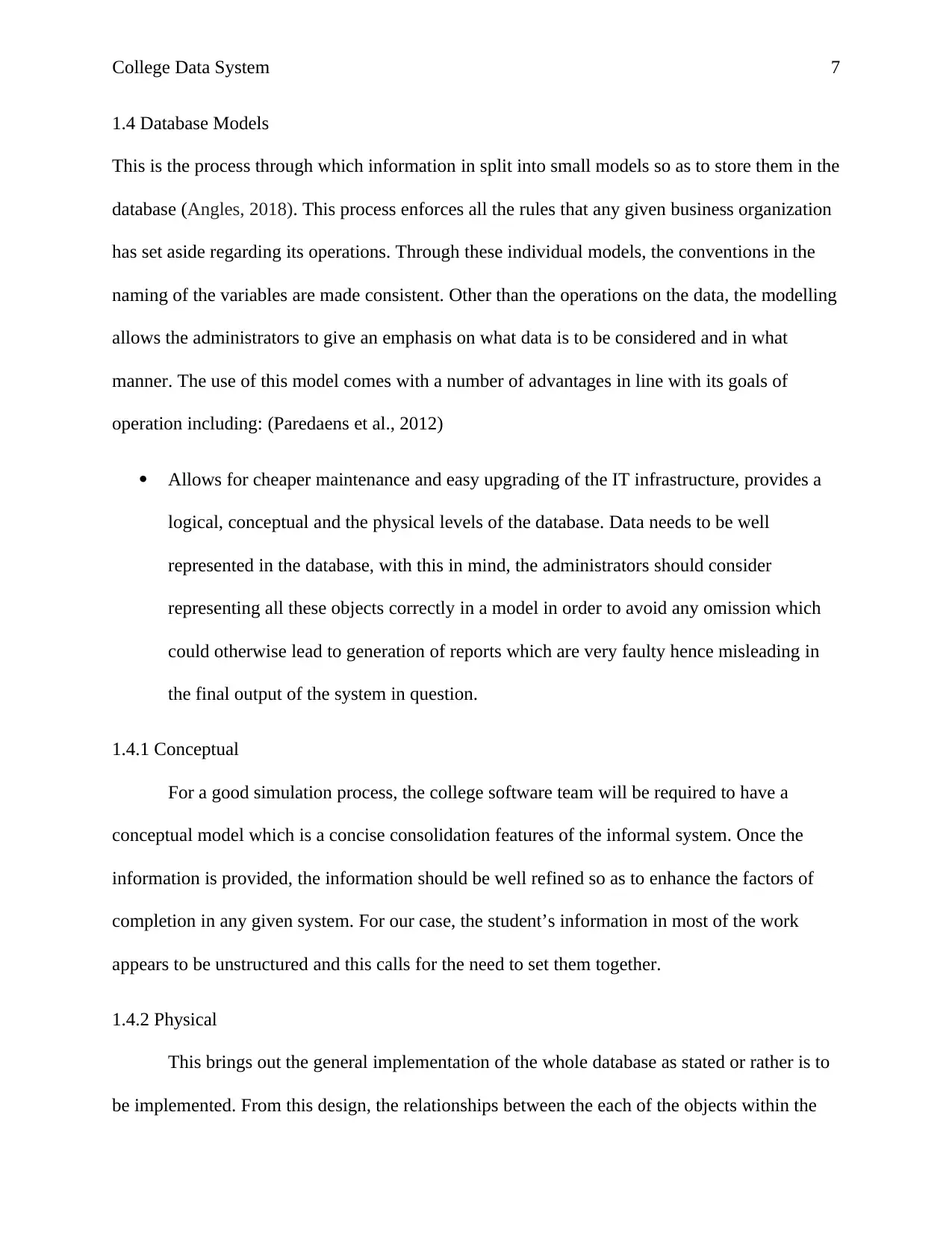
College Data System 7
1.4 Database Models
This is the process through which information in split into small models so as to store them in the
database (Angles, 2018). This process enforces all the rules that any given business organization
has set aside regarding its operations. Through these individual models, the conventions in the
naming of the variables are made consistent. Other than the operations on the data, the modelling
allows the administrators to give an emphasis on what data is to be considered and in what
manner. The use of this model comes with a number of advantages in line with its goals of
operation including: (Paredaens et al., 2012)
Allows for cheaper maintenance and easy upgrading of the IT infrastructure, provides a
logical, conceptual and the physical levels of the database. Data needs to be well
represented in the database, with this in mind, the administrators should consider
representing all these objects correctly in a model in order to avoid any omission which
could otherwise lead to generation of reports which are very faulty hence misleading in
the final output of the system in question.
1.4.1 Conceptual
For a good simulation process, the college software team will be required to have a
conceptual model which is a concise consolidation features of the informal system. Once the
information is provided, the information should be well refined so as to enhance the factors of
completion in any given system. For our case, the student’s information in most of the work
appears to be unstructured and this calls for the need to set them together.
1.4.2 Physical
This brings out the general implementation of the whole database as stated or rather is to
be implemented. From this design, the relationships between the each of the objects within the
1.4 Database Models
This is the process through which information in split into small models so as to store them in the
database (Angles, 2018). This process enforces all the rules that any given business organization
has set aside regarding its operations. Through these individual models, the conventions in the
naming of the variables are made consistent. Other than the operations on the data, the modelling
allows the administrators to give an emphasis on what data is to be considered and in what
manner. The use of this model comes with a number of advantages in line with its goals of
operation including: (Paredaens et al., 2012)
Allows for cheaper maintenance and easy upgrading of the IT infrastructure, provides a
logical, conceptual and the physical levels of the database. Data needs to be well
represented in the database, with this in mind, the administrators should consider
representing all these objects correctly in a model in order to avoid any omission which
could otherwise lead to generation of reports which are very faulty hence misleading in
the final output of the system in question.
1.4.1 Conceptual
For a good simulation process, the college software team will be required to have a
conceptual model which is a concise consolidation features of the informal system. Once the
information is provided, the information should be well refined so as to enhance the factors of
completion in any given system. For our case, the student’s information in most of the work
appears to be unstructured and this calls for the need to set them together.
1.4.2 Physical
This brings out the general implementation of the whole database as stated or rather is to
be implemented. From this design, the relationships between the each of the objects within the
Paraphrase This Document
Need a fresh take? Get an instant paraphrase of this document with our AI Paraphraser
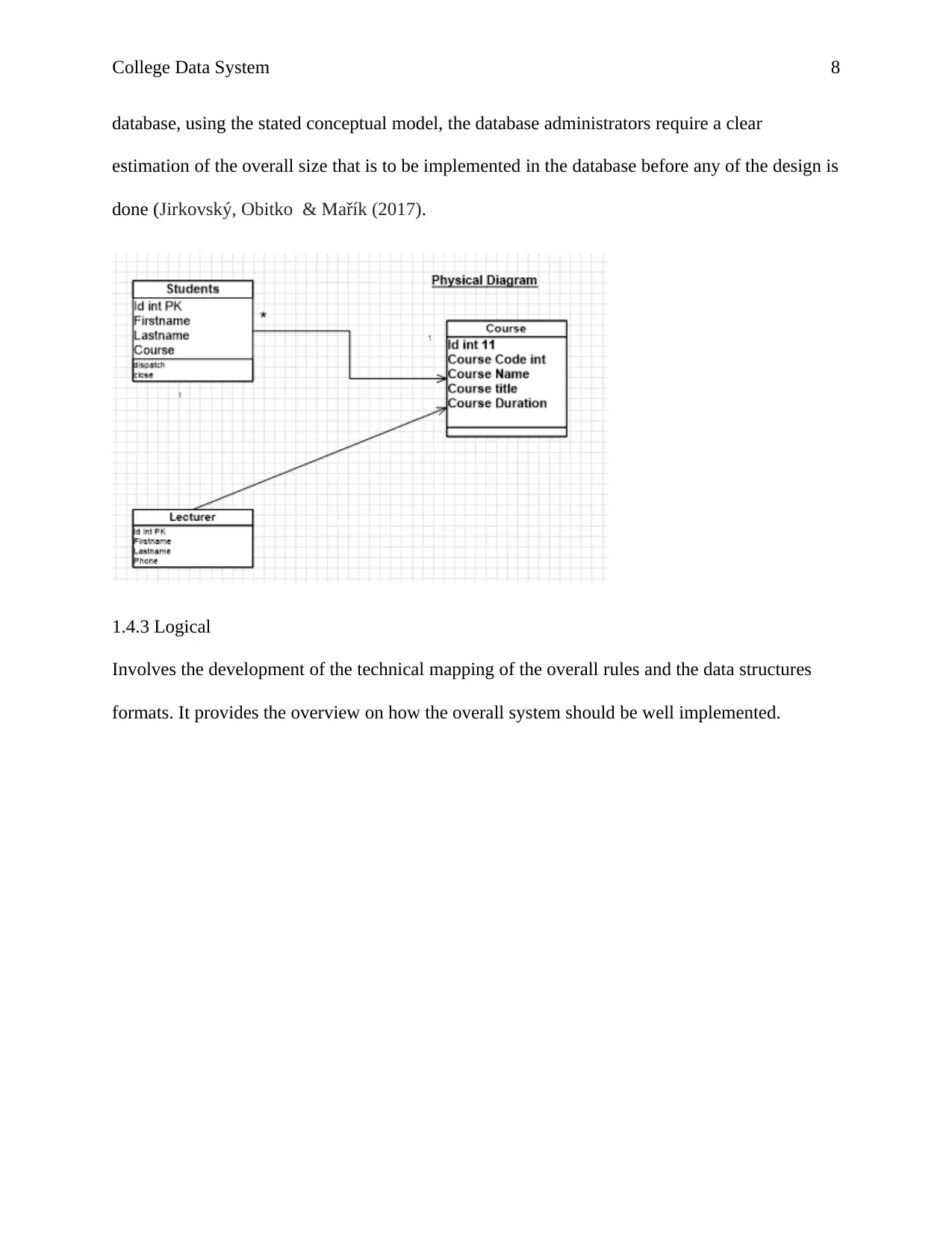
College Data System 8
database, using the stated conceptual model, the database administrators require a clear
estimation of the overall size that is to be implemented in the database before any of the design is
done (Jirkovský, Obitko & Mařík (2017).
1.4.3 Logical
Involves the development of the technical mapping of the overall rules and the data structures
formats. It provides the overview on how the overall system should be well implemented.
database, using the stated conceptual model, the database administrators require a clear
estimation of the overall size that is to be implemented in the database before any of the design is
done (Jirkovský, Obitko & Mařík (2017).
1.4.3 Logical
Involves the development of the technical mapping of the overall rules and the data structures
formats. It provides the overview on how the overall system should be well implemented.
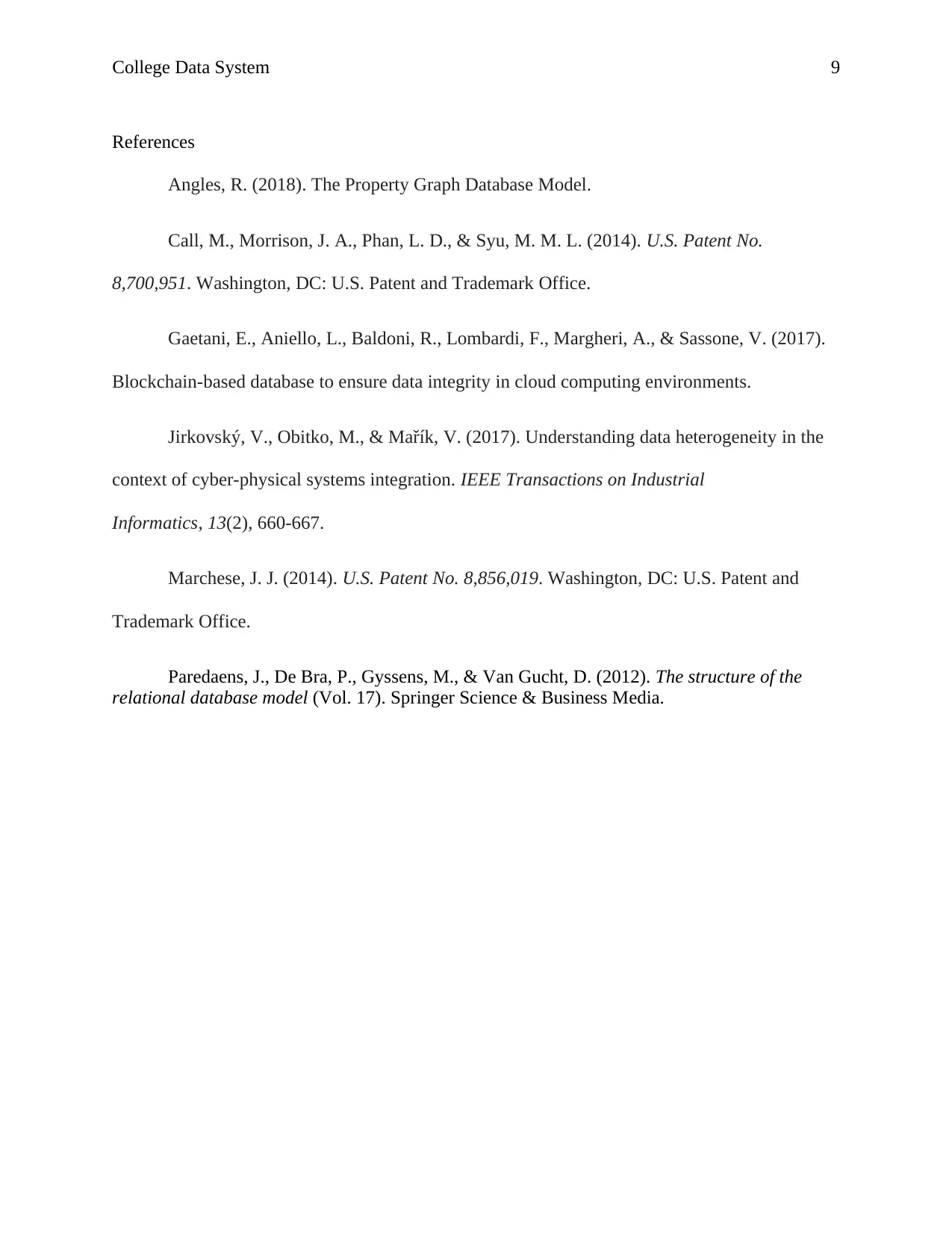
College Data System 9
References
Angles, R. (2018). The Property Graph Database Model.
Call, M., Morrison, J. A., Phan, L. D., & Syu, M. M. L. (2014). U.S. Patent No.
8,700,951. Washington, DC: U.S. Patent and Trademark Office.
Gaetani, E., Aniello, L., Baldoni, R., Lombardi, F., Margheri, A., & Sassone, V. (2017).
Blockchain-based database to ensure data integrity in cloud computing environments.
Jirkovský, V., Obitko, M., & Mařík, V. (2017). Understanding data heterogeneity in the
context of cyber-physical systems integration. IEEE Transactions on Industrial
Informatics, 13(2), 660-667.
Marchese, J. J. (2014). U.S. Patent No. 8,856,019. Washington, DC: U.S. Patent and
Trademark Office.
Paredaens, J., De Bra, P., Gyssens, M., & Van Gucht, D. (2012). The structure of the
relational database model (Vol. 17). Springer Science & Business Media.
References
Angles, R. (2018). The Property Graph Database Model.
Call, M., Morrison, J. A., Phan, L. D., & Syu, M. M. L. (2014). U.S. Patent No.
8,700,951. Washington, DC: U.S. Patent and Trademark Office.
Gaetani, E., Aniello, L., Baldoni, R., Lombardi, F., Margheri, A., & Sassone, V. (2017).
Blockchain-based database to ensure data integrity in cloud computing environments.
Jirkovský, V., Obitko, M., & Mařík, V. (2017). Understanding data heterogeneity in the
context of cyber-physical systems integration. IEEE Transactions on Industrial
Informatics, 13(2), 660-667.
Marchese, J. J. (2014). U.S. Patent No. 8,856,019. Washington, DC: U.S. Patent and
Trademark Office.
Paredaens, J., De Bra, P., Gyssens, M., & Van Gucht, D. (2012). The structure of the
relational database model (Vol. 17). Springer Science & Business Media.
⊘ This is a preview!⊘
Do you want full access?
Subscribe today to unlock all pages.

Trusted by 1+ million students worldwide
1 out of 9
Related Documents
Your All-in-One AI-Powered Toolkit for Academic Success.
+13062052269
info@desklib.com
Available 24*7 on WhatsApp / Email
![[object Object]](/_next/static/media/star-bottom.7253800d.svg)
Unlock your academic potential
Copyright © 2020–2025 A2Z Services. All Rights Reserved. Developed and managed by ZUCOL.





